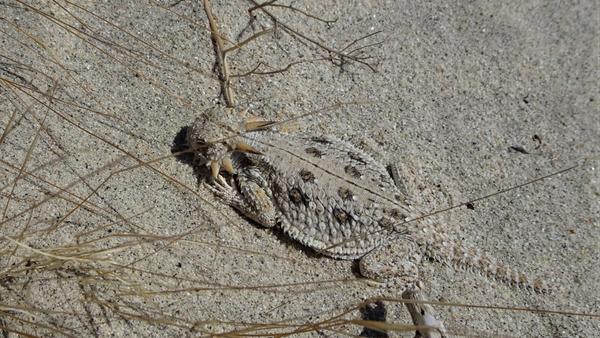What will the rain bring?
“Water is a desert’s gold.” — Matshona Dhliwayo
Wherever one lives, water is an essential ingredient of life. Where water is limiting, as it is in deserts, the amount and timing of rain dictates the abundance and richness of species to be found there. In deserts, early versus late winter rain, summer rain, and the time since the last drenching rain each result in different combinations of annual plant species. Those differences then impact differences in insect abundance and species richness, and those differences affect lizard abundances. So intertwined and powerful are these relationships that by just knowing rainfall amounts and timing we can accurately predict annual growth or decline in the abundance of Coachella Valley fringe-toed lizards. Usually. When there an occasional mismatch between rain and lizards, it can be a signal that there is a stronger force overriding that rainfall-lizard connection.
Along with fringe-toed lizards, since 2002 we have been tracking the abundance of flat-tailed horned lizards on the last remnant on the Coachella Valley floor where the horned lizards still occur. Due to land use changes and a resulting loss of aeolian sand habitat, the next closest flat-tailed horned lizard populations are south into the Anza Borrego Desert State Park, and on the opposite side of the Salton Sea a tenuous population may still exist near the Riverside-Imperial County line. Before land use changes, flat-tailed horned lizards probably enjoyed a continuous population from Indian Canyon Avenue in Palm Springs south into northern Baja California and northwestern Sonora, Mexico. With 20 years of data, as with the fringe-toed lizards, we should see a strong connection with the lizards’ annual population fluctuations and rainfall. We should, be we do not.
Our statistical analyses revealed a weak, non-significant negative relationship between the horned lizards’ abundance and both rainfall and harvester ants. Flat-tailed horned lizards, even more than other horned lizard species, are harvester ant specialists (the proper multisyllabic term is myrmecophagous) Fringe-toed lizards also eat ants, but they also eat plants and beetles and bees and just about anything. So, is there a difference in how the harvester ant populations respond to rainfall compared to what fringe-toed lizards consume? Or is there something else severing the rainfall-horned lizard connection? Ideally, we would have good data on annual harvester ant abundance, but we have found over the years that how many ants fall into the pitfalls we set out each year is as much related to whether we set the bucket near an ant colony, not their overall numbers. Our pitfall data tells us little about the ants.
We found a strong, statistically significant negative correlation between the horned lizards’ abundance and the invasive, non-native plant, Sahara mustard. But why would either the lizards or the ants care whether mustard or native wildflowers responded to rainfall. Given our frustration in accurately enumerating the ants in their habitat, we tried a different approach. We set up a series of “ant colony terrariums” and placed a harvester ant queen in each (after the virgin queens completed their one and only mating flight of their life, they can be abundant on sidewalks around the University as they look for just the right place to start their own colony). We then fed some just Sahara mustard seeds, and others we fed just a mix of native desert annual plant seeds. Those that were fed native seeds each survived for many months, laid eggs, and raised workers. Those fed just mustard seeds passed away after a couple months without producing workers. Those results need to be replicated, but they indicate a negative effect of the mustard on the ants.
Years with abundant early winter rains foster nearly homogeneous stands of Sahara mustard, sequestering all available sun and water, leaving native annuals with little or none. If the rains are less or come later in the winter, then a diverse assortment native desert annuals prevails. On the more active dunes where the fringe-toed lizards are more abundant, the mustard density is typically much lower; apparently the mustard has a low tolerance of the abrasive sand scouring everything in its path. This explains why, regardless of the rain patterns, rainfall is a more consistent predictor of fringe-toed lizard abundance. On the more stabilized sand fields where the flat-tailed horned lizard is found, there is much less sand abrasion and with more rain, much more Sahara mustard. For the horned lizards less (rain) is more (food and reproduction). Fortunately for the horned lizards, abundant early winter rains are not as common as less rain or later season rains, and while there are large fluctuations between years, over the 20 years of data, the horned lizard population is not on a negative trajectory. So here, in one of the hottest and driest deserts of North America flat-tailed horned lizards and harvester ants continue to thrive because it is so hot and dry, keeping the mustard from becoming dominant except occasionally when the rains favor the mustard.
By November, desert naturalists are anxiously looking to see when, or if, the winter rains will start. Of course, the hope is for a spectacular wildflower show. I hope so too, but I hope that if the rains push this far south and if they are strong enough to push over the mountains, that they do not come until later in January or early February when the mustard will lose its competitive edge over the native annuals. That, or I hope we find a means of keeping the Sahara mustard from overpowering the native species.
Nullius in verba
Go outside, tip your hat to a chuckwalla (and a cactus), think like a mountain, and be safe
